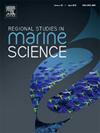A baseline assessment of the occurrence, characterization, source, and risk impact of petroleum-related hydrocarbons in sediments along the southeast shoreline of Vancouver Island and Southern Gulf Islands in British Columbia, Canada
IF 2.4
4区 环境科学与生态学
Q3 ECOLOGY
引用次数: 0
Abstract
Total petroleum hydrocarbons (TPH), n-alkanes, petroleum biomarkers, and polycyclic aromatic hydrocarbons (PAHs) were analyzed in 63 intertidal zone sediments from the southeast shoreline of Vancouver Island and the nearby Southern Gulf Islands, British Columbia (BC), Canada, using gas chromatography coupled with a flame ionization detector and mass spectrometry. All sites had TPH levels much lower than the Canadian Council of Ministers of the Environment thresholds for fine- and coarse-grained soils in agricultural and natural areas. Terrestrial plants were the main source of n-alkanes, though petrogenic n-alkanes were found in 13 % of 63 samples, as indicated by the carbon preference index (CPI) and related characteristics. PAHs primarily originated from pyrogenic input, with some locations showing mixed petrogenic and pyrogenic inputs based on analyzing diagnostic ratios, like pyrogenic index and certain isomer ratios. Petroleum contamination was evident at sites with intensive human activities or oil spill history, such as Cowichan Bay, Octopus Point, Medicine Beach, Fulford Harbor, East Portland, Separation Point, Maple Bay, and Aldridge Point, marked by significant levels of petroleum biomarkers, petrogenic n-alkanes, and PAHs. While all PAHs pose minimal risk to benthic organisms, compounds like naphthalene, 2-methyl naphthalene, and certain 3–6 ring PAHs could potentially affect them at certain sites from Cowichan Bay, East Portland, Separation Point, Medicine Beach, and Maple Bay.
对加拿大不列颠哥伦比亚省温哥华岛和南海湾群岛东南海岸线沉积物中石油相关碳氢化合物的赋存、特征、来源和风险影响进行基线评估
采用气相色谱-火焰电离检测器和质谱联用技术,对加拿大不列颠哥伦比亚省温哥华岛东南岸线和附近南海湾群岛的63个潮间带沉积物中的石油总烃(TPH)、正构烷烃、石油生物标志物和多环芳烃(PAHs)进行了分析。所有地点的TPH水平都远低于加拿大环境部长理事会对农业和自然地区细粒和粗粒土壤的阈值。碳偏好指数(CPI)和相关特征表明,陆生植物是正构烷烃的主要来源,但在63个样品中,有13. %的样品中发现了成岩正构烷烃。多环芳烃主要来源于热原输入,根据分析诊断比值,如热原指数和某些异构体比值,有些位置显示出岩原和热原混合输入。石油污染在人类活动密集或有石油泄漏历史的地点很明显,如coichan湾、Octopus Point、Medicine Beach、Fulford港、东波特兰、Separation Point、Maple Bay和Aldridge Point,其石油生物标志物、成岩正烷烃和多环芳烃的水平显著。虽然所有的多环芳烃对底栖生物的危害都很小,但像萘、2-甲基萘和某些3-6环多环芳烃这样的化合物可能会在coichan湾、东波特兰、Separation Point、Medicine Beach和Maple Bay等特定地点对底栖生物产生潜在影响。
本文章由计算机程序翻译,如有差异,请以英文原文为准。
求助全文
约1分钟内获得全文
求助全文
来源期刊

Regional Studies in Marine Science
Agricultural and Biological Sciences-Ecology, Evolution, Behavior and Systematics
CiteScore
3.90
自引率
4.80%
发文量
336
审稿时长
69 days
期刊介绍:
REGIONAL STUDIES IN MARINE SCIENCE will publish scientifically sound papers on regional aspects of maritime and marine resources in estuaries, coastal zones, continental shelf, the seas and oceans.
 求助内容:
求助内容: 应助结果提醒方式:
应助结果提醒方式:


